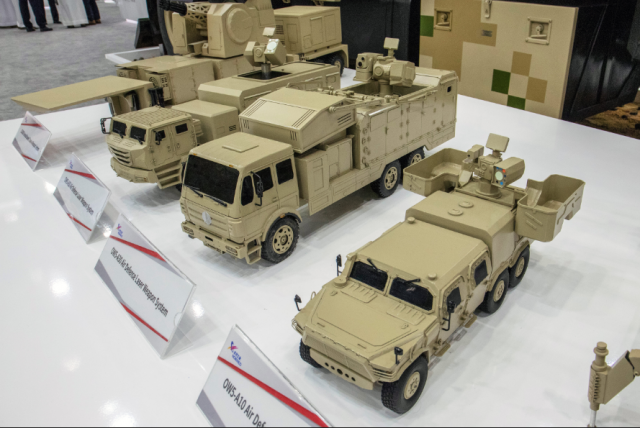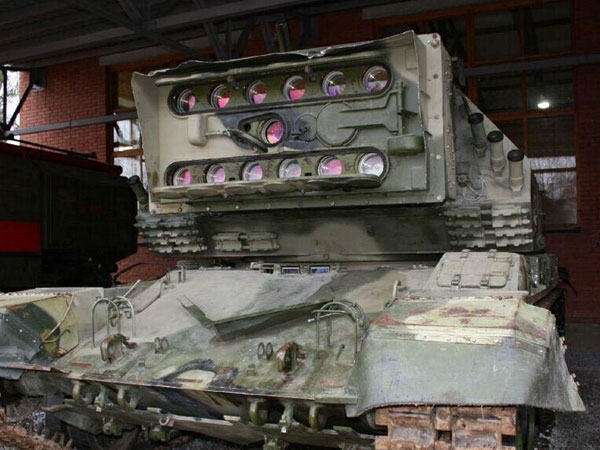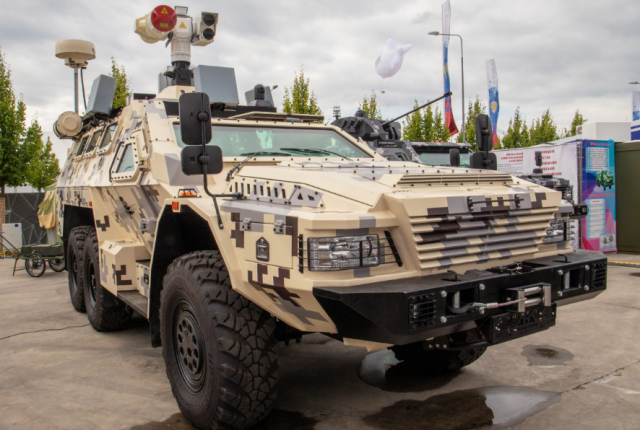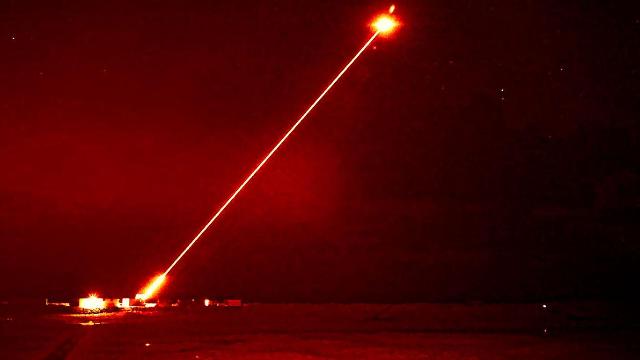The British Ministry of Defense has released footage of successful tests of the DragonFire laser weapon system, which hit an aerial target. The laser is capable of striking "any visible target", but is intended primarily for air defense (air defense). How the "death rays" came down from the pages of fantasy novels and gradually become weapons, what domestic developments were conducted and are being conducted in this direction — in the material of TASS
A video posted on the social network of the military department shows test firing of "powerful weapons against aerial targets." At the same time, the cost of one shot of the weapon, according to the British Ministry of Defense, is 10 pounds (a little more than 1 thousand rubles), but the firing range is not disclosed. Previous tests of the system were reported in January. "This type of modern weapon has the potential to radically change the theater of operations by reducing dependence on expensive ammunition and the threat of collateral damage," British Defense Minister Grant Shapps expressed optimism .
Burn from afar
Historians claim that two centuries before the new era, during the siege of Syracuse, Greek soldiers set fire to Roman warships from a distance. To do this, on the orders of the famous Greek scientist and engineer Archimedes, the warriors focused on the ships the sun's rays reflected from the highly polished metal shields. In 2005, students at the Massachusetts Institute of Technology confirmed the theoretical possibility of remote destruction of the Roman fleet by igniting a wooden mock-up using 130 small mirrors.
Science fiction writers of the XIX-XX centuries talked about weapons capable of instantly burning targets at long range. The combat tripods of the Martian invaders from the novel "The War of the Worlds" by British writer H.G. Wells fired with heat concentrated in rays that melted metal and evaporated water. Soviet science fiction writer Alexei Tolstoy in the 1920s, in the work "Hyperboloid of engineer Garin", described a device using a super-refractory mirror focusing the heat of "thermite checkers" into a "heat cord" that cut rock and dreadnoughts equally easily.
The creation of weapons that hit targets with directed energy became possible with the invention of a source of coherent electromagnetic radiation of high directivity — a laser (the acronym laser is derived from the English Light Amplification by Stimulated Emission of Radiation — "Amplification of light by forced radiation") in the middle of the XX century. Soviet scientists Alexander Prokhorov and Nikolai Basov, who were awarded the Nobel Prize in 1964 for their work, made a great contribution to the appearance of the device and the corresponding new sections of physics. Modern lasers have a different design, can work continuously or with powerful pulses, in addition to the visible spectrum, emit in other ranges of electromagnetic waves — infrared, X-ray.
"For a long time it was believed that the creation of a combat laser that can be used during combat operations is a kind of distant future," military analyst and editor of Arsenal of the Fatherland magazine Alexey Leonkov told TASS. According to him, for the first time, lasers as a weapon were discussed during the work within the framework of the Strategic Defense Initiative — the American program for the development of an anti-missile defense system (ABM) using combat laser complexes. The program was discontinued in 1993, but work continued on the creation of a laser for intercepting aerodynamic and ballistic targets. In 2010, the United States successfully tested an aircraft—based megawatt-class laser placed on an airplane - the weapon shot down two short-range ballistic missiles. However, a large transport aircraft with expensive equipment weighing about 300 tons will become easy prey for air defense, so its combat use is limited.
"The main drawback of laser weapons in the conditions of the Earth's atmosphere is the scattering of so—called coherent radiation," said Alexey Leonkov. — With each meter of range, the power of the laser beam is lost, its damaging properties are lost. If a laser can cut metals at a short distance, and we see this in industry, <...> the further the beam goes, the less its strength." Another disadvantage of the laser, according to the military analyst, is the low rate of fire, inferior, for example, to small arms. "For each shot, you will have to pump up the system <...> or come up with some kind of energy compensators in the form of high-capacity capacitors," the expert said. Therefore, laser systems for the physical destruction of targets are quite cumbersome. Alexey Leonkov expressed the opinion that the laser is inferior to traditional types of weapons as a means of destruction.
Lasers for every taste
Now more than a dozen countries have announced the creation and even adoption of various combat lasers: in addition to the United States and Russia, the "laser club" includes the United Kingdom, Germany, Israel, India, China, North Korea, Turkey, France, and Japan.
The United States and Germany have repeatedly tested high-power laser weapons mounted on ships.
Israel, which is constantly being subjected to rocket attacks from radical Palestinian groups, continues to improve the means of intercepting missiles. In 2022, the country tested the Iron Ray laser missile defense system, designed to destroy missiles and even mortar shells. According to open source data, one Iron Dome interceptor missile costs about $50,000, while a laser shot costs a few dollars. In the same year, Ukraine sent an official request to Israel for the purchase of the Iron Ray, but the Jewish state is in no hurry to satisfy it.
In 2014, China tested a laser installation capable of burning a small drone. Currently, the country offers several combat lasers of various capacities to foreign customers. At the IDEX 2023 international arms Exhibition in Abu Dhabi, the Chinese defense concern Norinco showed reduced models of laser installations for air defense AW5-A10, AW5-A30 and AW5-A50. Poly Technologies Corporation presented its car with an air defense laser.
 |
| Models of laser installations of the Norinco concern. |
| Source: Viktor Bodrov/ TASS |
At the end of March, India adopted a system for suppressing and destroying drones, which includes a kilowatt-class combat laser, and the first batch has already been received by the troops. The system is capable of detecting inconspicuous drones at a range of up to 8 km, destroying them with a laser beam from 800 m. The weapons are supposed to be deployed on the border with China. The countries have a hotbed of tension in the area of the border Indian state of Arunachal Pradesh, the territory of which China considers its integral part.
"The total amount of work carried out in other countries is, of course, impressive, but everyone came to about the same conclusion that a combat laser in atmospheric conditions can be used as a weapon that can "dazzle" electron-optical converters of high—precision weapons, intelligence," Alexey Leonkov shared his opinion, explaining, that when exposed to a coherent highly concentrated light beam, photodetectors of enemy equipment will burn out. At the same time, such a system will require much less energy to operate.
Soviet "scorchers"
The Soviet Union has been experimenting with lasers for defense purposes since the invention of the technology. Russian scientists have created prototypes of directed energy combat devices of all types and sizes. The most compact can be considered a laser pistol designed to arm Soviet cosmonauts. Using traditional firearms in zero gravity was difficult, and bullets could damage the skin of the space station. The pistol, which looks like a blaster from science fiction films, runs on disposable cartridges — pyrotechnic flashes synthesizing a laser beam. The eight-shot device was supposed to disable the optics of spacecraft, and from a distance of several tens of meters it could burn through a spacesuit.
Heavy ground—based "scorchers" were also developed - tracked armored support vehicles designed to "dazzle" the enemy's optoelectronic systems with a powerful laser. The most famous of them is the 1K17 complex "Compression", created in 1993. The uniqueness of the installation is that there are 12 optical channels with different laser radiation frequencies at once. If devices can be protected from a laser beam of the same frequency (for example, with special filters), then not from a dozen with different spectra at the same time.
 |
| A prototype of the 1K17 Compression laser system. |
| Source: weapon-planet.ru |
Alexey Leonkov shared his opinion that modern American developments of naval combat lasers repeat Soviet work in this direction. "At that time we had a specially converted leased vessel called the Dixon," the military expert said. — During the division of the navy, Ukraine got this ship. However, it got in the form when the entire power plant and the combat laser that stood there were dismantled." Answering the question whether modern shipboard lasers can withstand marine kamikaze drones, the specialist noted that experienced Dixon firing at a distance of more than 2 km showed heating of the target surface by only 10%. The reason for the low effectiveness of the weapon, in his opinion, was the influence of two media on the laser beam at once — air and sea. The corporate magazine of the United Shipbuilding Corporation called the Dixon the world's first ship — an experimental carrier of high-energy weapons.
Russian lasers: the present and the future
Russian President Vladimir Putin said that the Armed Forces of the Russian Federation must be equipped with promising types of weapons, including combat lasers. "I mean robotic complexes and combat lasers, weapons using artificial intelligence technologies and based on new physical principles," the head of state said, speaking at a meeting of the board of the Ministry of Defense of the Russian Federation at the end of last year.
Currently, several combat lasers have been developed in Russia. One of them, the Peresvet laser complex, was announced by Vladimir Putin in a message to the Federal Assembly in March 2018. The complexes have already entered service with the Russian Aerospace Forces. According to Yuri Borisov, Peresvet is capable of disabling species reconnaissance satellites in orbits up to 1.5 thousand km. Borisov also noted that Russian scientists are working to increase the power of such installations for thermal destruction of targets.
 |
| The "Army” complex with a system of directional laser destruction. |
| Source: Viktor Bodrov/ TASS |
An example of modern domestic weapons that can burn small drones with a laser beam is the "Rat" complex, presented by the Rostec State Corporation's Roselectronics holding at the Army-2023 forum. In one of the modifications, the "Army" is armed with a system of directed laser destruction. According to the materials presented during the forum, the complex detects an enemy UAV at a distance of up to 3.5 km, tries to suppress control channels when it approaches, and physically destroys it at a distance of 1 km.
According to Yuri Borisov, in the course of a special military operation, laser systems "Zadira" are already being used, hitting targets at a distance of up to 5 km.
Victor Bodrov


